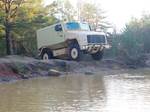Hybrid Enhanced Combat Helmet enters final testing phase
The U.S. Army and Marine Corps are conducting final validation testing of the U.S. military’s next-generation — and radically new — thermoplastic composite Enhanced Combat Helmet (ECH).
The U.S. Army and Marine Corps are conducting final validation testing of the U.S. military’s next-generation — and radically new — combat helmet at the Army Research Laboratory’s Aberdeen Proving Ground in Maryland. Testing on the Enhanced Combat Helmet (ECH), is expected to last 6 to 12 months. The previous-generation Advanced Combat Helmet (ACH) — currently in use by most U.S. combat troops — is made primarily of Kevlar and phenolic resin. The ECH will be the first to incorporate thermoplastic resin in its construction. Military sources tell HPC that the ECH comprises a carbon-fiber inner cage overmolded with a preform made from Spectra ultrahigh-molecular-weight polyethylene (UHMWPE), supplied by helmet development partner Honeywell Advanced Fibers and Composites (Colonial Heights, Va.).
“The ECH involves a change in materials, a change in the manufacturing process and a change in the specifications,” says Honeywell’s armor industry technical leader Lori Wagner. While the UHMWPE outer hemisphere imparts the energy-absorbing antiballistic behavior, the carbon inner cage is designed to resist deformation, offering better local-impact protection for the wearer. The design reportedly results in a 10 percent improvement in ballistic protection while reducing helmet weight.
The military is expected to issue production contracts to several manufacturers. The helmet will be made using an out-of-autoclave, automated compression-style press. Automation is expected to reduce the cost of making the ECH by 10 to 15 percent compared to the ACH.
Related Content
-
TU Munich develops cuboidal conformable tanks using carbon fiber composites for increased hydrogen storage
Flat tank enabling standard platform for BEV and FCEV uses thermoplastic and thermoset composites, overwrapped skeleton design in pursuit of 25% more H2 storage.
-
Plant tour: Joby Aviation, Marina, Calif., U.S.
As the advanced air mobility market begins to take shape, market leader Joby Aviation works to industrialize composites manufacturing for its first-generation, composites-intensive, all-electric air taxi.
-
Infinite Composites: Type V tanks for space, hydrogen, automotive and more
After a decade of proving its linerless, weight-saving composite tanks with NASA and more than 30 aerospace companies, this CryoSphere pioneer is scaling for growth in commercial space and sustainable transportation on Earth.












